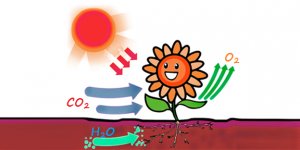We are indulged in a lot of daily activities. To carry out these activities a large amount of energy is required. This energy comes from the food we consume. Food is vital as it provides the energy needed for growth, repair, and other life processes. All these come under the life process called nutrition.

Let’s learn about nutrition and different types of nutrition in detail.
What is Nutrition?
“Nutrition is the process of taking in food and converting it into energy and other vital nutrients required for life.”
Nutrients are the substances which provide energy and biomolecules necessary for carrying out the various body functions. All living organisms need nutrients for proper functioning and growth. But they show divergence in how they fulfill this demand. Some animals feed on simple inorganic compounds to meet their nutrient requirement, while others utilise complex compounds. The mode of nutrition varies from one species to another.
Also Read: Nutrition in Plants
Types of Nutrition
Broadly, there are two types of nutrition among living organisms, namely:
- Autotrophic mode
- Heterotrophic mode
Autotrophic Nutrition
In the autotrophic mode, organisms use simple inorganic matters like water and carbon dioxide in the presence of light and chlorophyll to synthesize food on their own. In other words, the process of photosynthesis is used to convert light energy into food such as glucose. Such organisms are called autotrophs. Plants, algae, and bacteria (cyanobacteria) are some examples where autotrophic nutrition is observed.
During photosynthesis, carbon dioxide and water get converted into carbohydrates. These carbohydrates are stored in the form of starch in plants. Plants later derive the energy required from the stored starch. The process of photosynthesis can be explained in three stages:
- Absorption: The chlorophyll present in leaves traps the light coming from the sun.
- Conversion: The absorbed light energy gets converted into chemical energy. And water absorbed will split into hydrogen and oxygen molecules.
- Reduction: At last, carbon dioxide gets reduced i.e. hydrogen molecules combine with carbon, to form carbohydrates (sugar molecules).

Autotrophic Nutrition
![]()
All three events are not a continuous process. They may or may not take place sequentially.
In plants, stomata are the openings on leaves where gaseous exchange takes place and is regulated by guard cells. Plants take in and release gases through these stomatal pores.
In desert-like habitats, to avoid water loss, guard cells keep these pores closed during the daytime. Later, during the night time, stomata will be opened to absorb carbon dioxide and store in the vacuoles. During the daytime, they will use this stored carbon dioxide to perform photosynthesis.
Other than photosynthesis, plants also depend on soil for micro and macro elements. These elements are used to synthesize proteins and other essential compounds required for the proper functioning and growth of the plants.
Also Read: Nutrition in Animals
Heterotrophic Nutrition

Heterotrophic Nutrition
Every organism is not capable of preparing food on its own. Such organisms depend on others for their nutrition. The organisms which cannot produce food on their own and depend on other sources/organisms are called heterotrophs. This mode of nutrition is known as heterotrophic nutrition.
Fungi and all the animals including humans are heterotrophs. Heterotrophs can be of many varieties depending upon their environment and adaptations. Some may eat plants (herbivores) and others eat animals (carnivores) while few eat both (omnivores). Thus we can say survival of heterotrophs depends directly or indirectly on plants.
Heterotrophs are classified into different categories based on their mode of nutrition. They are:
- Parasites (e.g. leeches, ticks)
- Saprophytes (e.g. mushrooms)
- Holozoic (e.g. humans, dogs)
Also Read: Photosynthesis
To learn more about what is nutrition and different types of nutrition, keep visiting BYJU’S website or download BYJU’S app for further reference.
Frequently Asked Questions
What are the different modes of nutrition in living beings?
The different modes of nutrition include:
- Autotrophic nutrition
- Heterotrophic nutrition
What are the different modes of heterotrophic nutrition?
The different modes of heterotrophic nutrition include:
- Parasitic
- Saprophytic
- Holozoic
What is holozoic nutrition? Which organism exhibits holozoic nutrition?
Holozoic nutrition is the mode of heterotrophic nutrition that involves ingestion, digestion, absorption and assimilation of solid and liquid material. This type of nutrition is exhibited by amoeba that takes in complex substances and converts them into simpler substances.
What are mixotrophs?
Mixotrophs are organisms that use a mix of different sources of energy and carbon rather than a single trophic mode. Euglena is an autotroph as well as a heterotroph and is called a mixotroph.
Are all protists mixotrophs?
Not all protists are mixotrophs. A few protists are strict heterotrophs. While a few are both autotrophs and heterotrophs. The mixotrophic protists are called acetate flagellates.
What is the mode of nutrition in plants?
Plants exhibit an autotrophic mode of nutrition because they can prepare their own food. Plants use sunlight, water and carbon dioxide to produce energy during photosynthesis.
Why is nutrition essential for a living organism?
Nutrition is very important to lead a healthy life. A balanced diet reduces the risk of diseases and improves the overall health of an organism. It provides energy to the cells to carry out the cellular activities.
What is the mode of nutrition in blue-green algae?
Blue-green algae can be autotrophs, heterotrophs or mixotrophs.


I like this app when I have any doubt I open byjus and clear my doubts
Thanks so much!
I like this app very much it clears my doubts and very good explanation
I like this app very much it clears my doubts and very good explanation
Nice
great
I like this app. Its very helpful and amazing
Very much good to study
This notes is really great without any teacher explanation our doubt are clear because of this notes
A wonderful app i like it . My all doubt are clearly explaintion here. This app is help in study . And it’s notes is awesome.